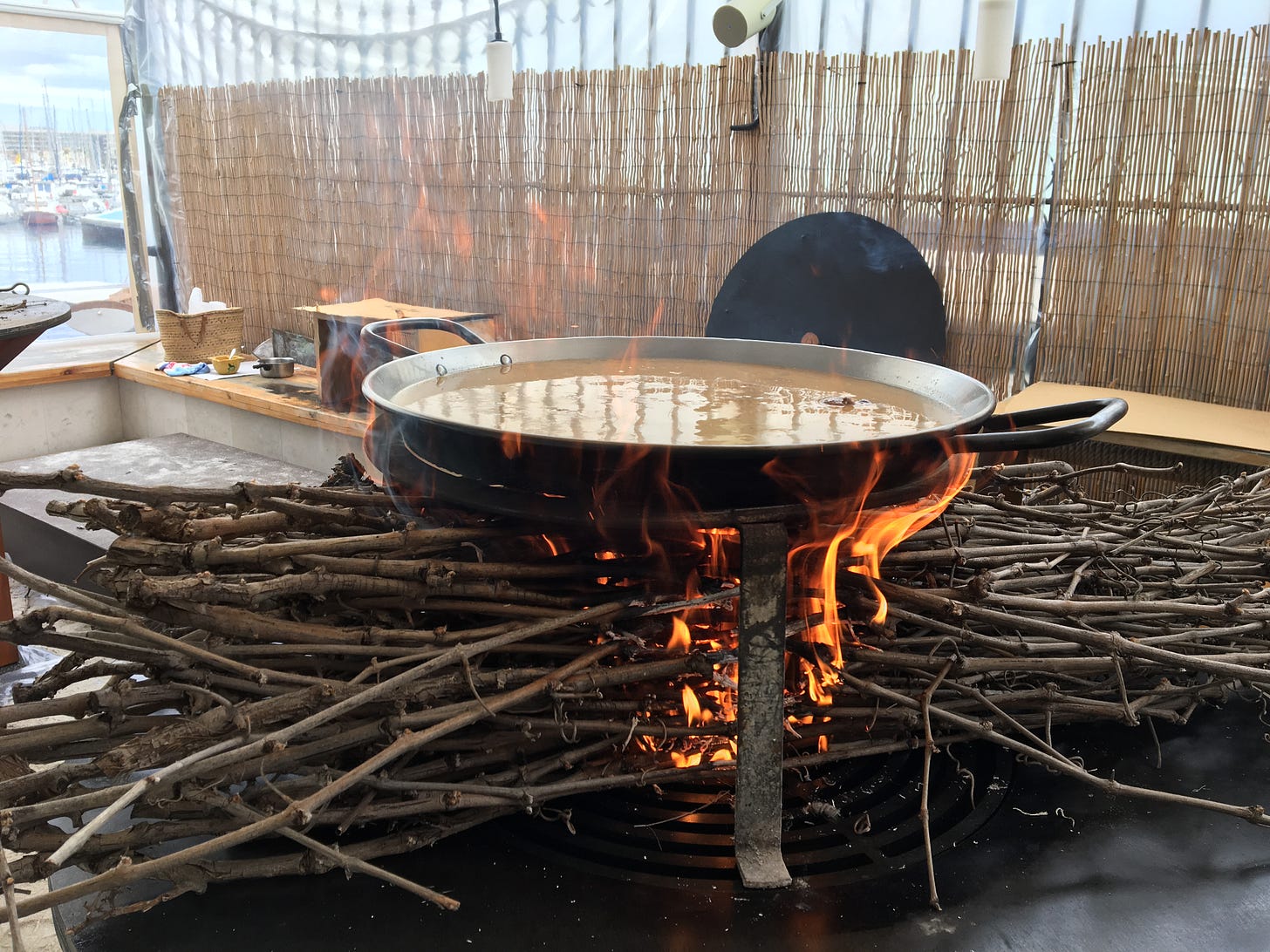Day 3: Cooking on Instincts
What makes a perfect paella? Temperature, timing and intuition.
A paella pan is lifted onto the pass, so large its edges overhang the countertop.“ A comer!” commands Federico, and we don’t need to be told twice.
Guinea pigs
The staff meal at El Monastrell, the restaurant, where I’m on a chef stage usually lands on the pass around 12.30am; if we are lucky it will come in from the outdoor fire pit, and it will be a paella cooked by head chef, Federico Pian.
Federico needs guinea pigs. Not literally (I hasten to add), but he needs mouths to feed. Next month, he will compete in the International World Paella Championships, and is practising the recipe daily.
Today it turns out we are in luck.
The door swings open and smoke blows into the kitchen from outside. A paella pan is lifted onto the pass, so large its edges overhang the countertop.
“A comer!” commands Federico, and we don’t need to be told twice.
It’s soon gone. Each caramelised grain of rice is scraped from the base of the pan, the last smears of red saffron oil mopped up with bread.
Soon, the rabbit is just bones on our plates, the snails just empty shells.
It is one of Federico’s best. We tell him, he barely nods, giving little away, he knows this paella business is a fickle art to master.
World Paella Championships
At the World Paella Championships each team will use the exact same paella ingredients.
As well as rabbit, chicken, green beans, white butter beans the official recipe also calls for snails.
To practise his art, Federico is using the official ingredients each day.
Despite being made with the same ingredients, each paella Federico cooks is subtly, yet significantly different.
And it’s mastering those differences that turns good paella into the best paella recipe in the world.
But, what is it? What makes the difference between a good paella and a great paella? What makes it the greatest paella in the world?
Temperature, time and instincts
“It's about using your instincts,” Federico tells me. “You need to listen to the rice, watch it, smell it.”
Watching Federico cook a paella reminds me of a shark circling its prey.
For 16 minutes or so the rice is cooking, Federico doesn’t stop makes adjustments. He moves quickly around the flames, watching for the right amount of bubbles, intuiting if he needs to push more wood through so the flame burns hotter.
Temperature control is vital to ensuring the rice cooks properly, with the first and last few minutes at max, with a period of lower heat in-between.
Federico seems to have mastered this, and the flame burns brighter and the rice cooks faster for just the amount of minutes he commands it to do so.
He instinctively knows and recognises the signals.
In sport, this is called intuition. For many years, I competed in the sport of judo, becoming a judo world champion and winning silver at the 1992 Olympic Games and learning to trust your gut instinct was paramount.
Gut instinct is when you act or react without conscious thought or decision.
Some of the best judo throws happen like this. You sense it is the right moment to attack, and you have attacked before you know it, your opponent is on their back.
And the same is true in defence. Your body knows to recoil and withdraw, as your opponent moves forward. You move before you consciously have realised you need to defend.
You don’t have time to logically think things out. Over thinking will just slow you down. Your body reacts instantly and instinctively.
Intuition is subconscious process, one you need to recognise and allow yourself to trust in. You must trust yourself and go with the flow.
Federico is doing just that. He is cooking on intuition. He just knows the rice needs more liquid, he knows to push the twigs through to create more heat, he senses when the rice is done.
“And it’s about practice,” Federico says looking up from the paella for a mili second towards me.
I know today’s lunch will be another master-piece, but I also want to get to the nitty-gritty of it.
What is it? Why are some paellas perfect?
Over the next month, I eat 17 paellas for staff meals.
For me, it’s a crash course in understanding the finer details of the Spanish paella.
By rice number 9 or 10, I’m beginning to get it.
My education is helped by the kitchen staff who verbally dissect each last grain. Put any group of Spaniards around a paella, and they will do the same.
Chefs are no different, and lunch soon becomes a forensic examination.
What about the arroz? Does it have enough bite? Too salty? Too bland? Is the rabbit still tender? And the all important question: is there socarrat?
Socarrat is the thin layer of rice on the bottom of the pan that has caramelised. Deep brown in colour, a good socarrat adds an extra dimension to any paella.
After each lunch, I added some of the most important points to come out of the chef’s discussions into my notebook.
And I thought I’d share some of those with you now.
Since this chef stage, I’ve made countless paellas. I’ve made them at home just for the two of us, I’ve made them for groups of friends, and I’ve made those huge paellas for over 50 people.
And I urge you to have a go. Although mastering the paella might take some years, nailing the basics is easier than you think.
Here are 10 golden rules to follow as you develop your paella instincts.
Want to join me on this journey?
For the next 100 Days I’m staging in Spanish Michelin star restaurants. In the next episode, things get a price put on them. I learn about the value of working for free. You get 10 top tips on getting organised.
If you want to join me for the next episode, add your name to the list.
Perfect Paella: 10 Golden Rules
Ten tips to make sure your rice is rocking.
Related Recipes
Sofrito
Seafood Paella
1. Choose the right rice
The supermarkets are making it easy these day with Spanish Paella Rice on their shelves. Perfecto! Medium grain varieties like Bomba, Senia, JSendra or Albufera are used in Spain.
2. Resist the temptation to stir
Stirring the rice breaks the grains, releasing starch into the liquid and making a creamy risotto. Not what we want. We want intact, separate grains that have absorbed all the stock. So, once your rice goes in, you can gently move it so it’s not in clumps then that’s it. Spoon out. Don’t touch it again. Keep the faith, it will turn out just fine.
3. Stock = Flavour
Paella gets its flavour mainly from the stock. If the stock is wonderfully deep, complex, intense and tasty - then your rice will be too. Use shop bought stocks if you are short on time, but make sure they are quality. If do take the time to make your own stock you will reap the rewards.
4. Correct Size Pan (Paellera)
Don’t crowd the pan. You can’t just pile in more and more rice, when you have more people over. It doesn’t work. The rice doesn’t cook evenly. A paella shouldn’t be deep, the rice should be a thin layer. If you need to cook more rice, then you need a wider bigger paellera.
5. Keep to the ratios
So, this bit is science. Don’t wing it. Get the scales out and stick to the ratios.
Each rice grain absorbs 2.5 to 3 times its weight in liquid.
Weigh your rice (you need approx 80g to 100g per person) and multiply that number by 3 to get the quantity of stock you need.
The ratio is an easy one to remember 3:1 (stock to rice).
6. Use good oil
You will notice the difference. Use a good quality extra virgin olive oil. Take your paella skills up a notch by flavouring these oils to mirror your key ingredients.
7. Add in more flavour
The paella gains flavour from sofrito and spices.
Sofrito is a slow-cooked aromatic mix of tomato, garlic and onion. Learn to make a good sofrito, you won’t regret it. Spices used are pimenton (unsmoked paprika) and saffron.
8. Whatever you do, don’t forget the salt.
An unsalted paella is probably the sin of all the paella sins. It is at least in my house, when my wife will let me know loud and clear it is “Sosa!” - bland!
You must add salt at the start of the cooking. Add to the stock, slightly over seasoning, allowing for the rice. It will be too late to sprinkle some ontop at the end (I have tried!)
9. Time is precise
Bomba rice will take between 16-18 mins to cook. As the rice goes in, start your timer. Keep the heat high for the first 3-5 mins until you see grains appear. Then turn down to a medium heat. For the final minute turn the heat up again to drive off the last bit of liquid and create the socarrat.
Each grain should be intact, separate and soft. You can do a sneaky test by pulling out some grains, trying them and then covering your tracks.
10. Listen for the crackle
Socarrat is the sought-after caramelised bottom layer of rice. Just the right side of being burnt, a good socarrat should be deep brown, sweet and nutty. Nail the socorrat and you are well on the way to making the best paella of your life.
To achieve socarrat you need to increase the heat for the final two minutes of the cooking time and listen for the crackle. That’s the sound of the rice frying in the oil as the last of the stock is absorbed.
And btw…
Oh and by the way, I almost forgot to tell you the end of the story but I’m sure you will want to know that Federico and his intuition were in full flow at the World Paella Championships where he came second, only beaten by Bon Aire, a team from Valencia who officially make the best paella in the world.
A cooking course in your inbox each week!
Join me, Nicola Fairbrother as I stage for 100 days in a professional kitchens in Spain.
Personal stories of life in a professional kitchen.
Read this one to get an idea of what you can expect.
Plus recipes and culinary techniques from Spain's best restaurants.
Visual tutorials designed to help you absorb the whole process quickly and easily.
Here’s an example.
Improve your cooking skills with Olympian in a Kitchen.


















No eres sosa ni tu ni tu paella. La de hoy de 10, pero es un arroz 😜